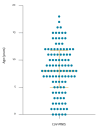SARS-CoV-2-related paediatric inflammatory multisystem syndrome, an epidemiological study, France, 1 March to 17 May 2020
- PMID: 32524957
- PMCID: PMC7336112
- DOI: 10.2807/1560-7917.ES.2020.25.22.2001010
SARS-CoV-2-related paediatric inflammatory multisystem syndrome, an epidemiological study, France, 1 March to 17 May 2020
Abstract
End of April 2020, French clinicians observed an increase in cases presenting with paediatric inflammatory multisystem syndrome (PIMS). Nationwide surveillance was set up and demonstrated temporospatial association with the coronavirus disease (COVID-19) epidemic for 156 reported cases as at 17 May: 108 were classified as confirmed (n = 79), probable (n = 16) or possible (n = 13) post-COVID-19 PIMS cases. A continuum of clinical features from Kawasaki-like disease to myocarditis was observed, requiring intensive care in 67% of cases.
Keywords: COVID-19; Kawasaki disease; SARS-CoV2; children; inflammation; myocarditis; post-infectious disease.
Conflict of interest statement
Figures





References
-
- World Health Organization (WHO). Multisystem inflammatory syndrome in children and adolescents temporally related to COVID-19. Geneva: WHO: 15 May 2020. Available from: https://www.who.int/news-room/commentaries/detail/multisystem-inflammato...
-
- Health Alert Network. Multisystem Inflammatory Syndrome in Children (MIS-C) Associated with Coronavirus Disease 2019 (COVID-19) CDCHAN-00432. Atlanta: Centers for Disease Control and Prevention; 14 May 2020. Available from: https://emergency.cdc.gov/han/2020/han00432.asp
-
- Health Policy Team. Guidance - Paediatric multisystem inflammatory syndrome temporally associated with COVID-19. London: Royal College of Paediatrics and Child Health. Available from: https://www.rcpch.ac.uk/resources/guidance-paediatric-multisystem-inflam... (accessed May 30, 2020).
MeSH terms
Supplementary concepts
LinkOut - more resources
Full Text Sources
Miscellaneous
